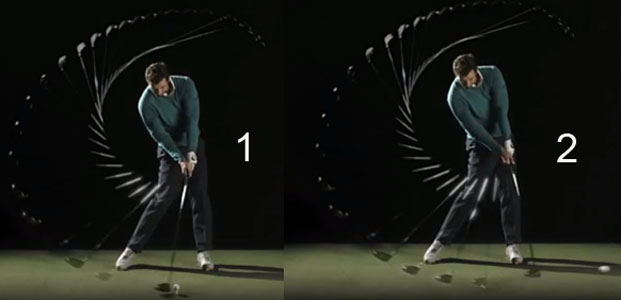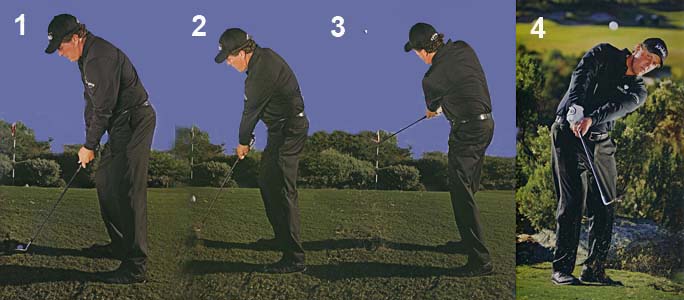
What is the difference between a handle-dragging technique and the intact LAFW/GFLW technique?
Click here to go back to the video project's index page.
When using the intact LAFW/GFLW technique during the downswing,
a golfer is simply trying to continuously swing the intact LAFW as an intact
(structurally single) unit so that the clubshaft always travels at the same
angular velocity as the left arm in the horizontal plane of motion (which is, by
definition, also in the plane of motion of left wrist hinging). Done correctly,
this means that the clubshaft will never travel faster than the left arm (from
an angular rotational perspective) and the left wrist will never flip (extend)
in any way to disrupt the single unit LAFW. During the
early-mid downswing, when the intact LAFW is lying parallel to the inclined
plane, and when the clubshaft is moving down the inclined plane in the general
direction of the ball-target line, it is not that difficult to maintain an
intact LAFW because the club is releasing within the plane of radial => ulnar
deviation, which lies within the plane of the intact LAFW. During that time
period, the back of the GFLW is lying parallel to the inclined plane and there
are no club-releasing forces operating in the plane of left wrist unhinging (if
the clubshaft remains continuously "on-plane"), so it is not that difficult to
maintain a GFLW during that time period. However, in the later downswing between
P6.5 and impact, when the back of the GFLW rotates counterclockwise to face the
target, it requires a greater amount of skill to maintain an intact LAFW/GFLW
because the club is moving towards the target at a certain speed (due to the
momentum that it has gained during the release of PA#2) and a golfer has to
maintain the forward/targetwards speed of the left arm to perfectly match the
forward/targetwards speed of the clubshaft from an angular velocity perspective
if he wants to maintain an intact LAFW/GFLW through the late downswing and then
also through the immediate impact zone between impact and P7.2. When a golfer
attempts to maintain an intact LAFW/GFLW throughout the late downswing from P6.5
to impact, and then even further to P7.2, he is simply trying to prevent the
clubshaft from bypassing his left arm due to a left wrist bending (extension)
phenomenon, and he is not trying to sustain clubhead lag (where the clubhead doesn't catch up
to the left arm). When using the intact LAFW/GFLW swing technique in the
standard manner, a golfer
allows PA#2 to fully release so that the clubhead can catch up to the left arm
by low point (which is usually located at a point that is vertically below the
left shoulder socket) and he does not deliberately try to sustain clubhead lag and ensure that he has
a large amount of forward
shaft lean at impact (due to the presence of sustained clubhead lag).
Here are capture images of Adam Scott using the intact LAFW/GFLW technique for his driver swing.

Image 1 is at impact, and image 2 is at P7.2.
Adam Scott has placed his ball just behind low point, and he allows his releasing clubshaft and clubhead to catch up to his left arm by low point, and he does not deliberately attempt to sustain clubhead lag throughout his entire downswing so that he comes into impact with a large amount of forward shaft lean secondary to an intentional attempt to prevent the complete release of PA#2.
Between impact (image 1) and P7.2 (image 2) he is matching the forward/targetwards motion of his left arm so that it perfectly matches the forward/targetwards motion of his clubshaft, and that allows him to maintain an intact LAFW/GFLW throughout the immediate impact zone between impact and P7.2. During that time period, his left arm and clubshaft are in a straight-line relationship and he therefore doesn't have the condition of "sustained clubhead lag".
By contrast, when using a handle-dragging technique, a golfer is deliberately trying to come into impact with a significant amount of forward shaft lean and a bowed (palmar flexed) left wrist, which means that he is deliberately trying to sustain clubhead lag all the way into impact (and often beyond impact).
Here is an example of a golfer - Jordan Spieth - using a handle-dragging technique when hitting a short iron shot.
Here are capture images from the swing video.

Image 1 is at impact. Note that Jordan Spieth has placed his ball far back in his stance, so that it is closer to his right foot. Note that he has his hands well forward of the ball at impact with a bowed left wrist and a lot of forward shaft lean. Note that he maintains a bowed left wrist and forward shaft lean for many inches post-impact - while his clubhead is plowing through the ground. Note that he maintains a very bent right wrist during this time period, and he is likely applying a significant amount of push-pressure with his right palm against PP#1 over the base of his left thumb into-and-through impact, in order to help him"stabilise" his bowed left wrist throughout the clubhead's travel time through the immediate impact zone.
This type of handle-dragging technique is frequently used by professional golfers when they want to hit low-trajectory punch shots, and I suspect that the handle-dragging technique gives them maximum "stability" control over their clubhead/clubface through impact - albeit at the expense of maximum clubhead speed.
Some professional golfers also this handle-dragging technique for certain types of chipping shots around the green, when they want the clubhead to come into impact down a very steep clubhead path (which will produce a larger negative clubhead attack angle) and which technically requires a lot of forward shaft lean and the presence of "sustained clubhead lag".
Phil Mickelson even uses a variation of the handle-dragging technique (when he uses an exaggerated version of his "hinge-and-hold" technique) for flop shots around the green.

When hitting a flop shot using his "hinge-and-hold" technique, Phil Mickelson places the ball closer to his front
foot because he does not want to have a lot of forward shaft lean at impact
(which will decrease the dynamic loft of the clubface at impact). To ensure that
his clubface is wide open at impact, he first lays-back the back of his lob
wedge's clubhead so that it is lying flat against the ground, which means that
the front surface of his clubface is facing distinctly skywards (image 1). Then,
to ensure that his clubface remains wide-open through impact, be maintains a
slightly bowed lead wrist (AFLW) and a small degree of forward shaft lean
through impact, and he also simultaneously pronates his lead forearm through
impact to ensure that his clubface still faces skywards when his clubhead is
well beyond impact (as seen in image 3 and image 4). Note that Phil Mickelson i) never lets the clubshaft catch-up to his lead arm throughout the late downswing
and throughout the entire immmediate impact zone time period, and note that ii)
he still has a bowed lead wrist and very bent rear wrist in images 3 and 4 - and
those two biomechanical features are very characteristic of a handle-dragging
technique.
The amount of left wrist bowing present at impact during a handle-dragging technique varies widely, and here is an example of a golfer - Michelle Wie - who only has a bare minimum amount of left wrist bowing when performing a swing action which looks very much like a handle-dragging technique in the sense that she has a lot of forward shaft lean at impact.

Note that Michelle Wie has placed the ball further back in her stance, so that
it is closer to her right foot. That will allow her to get her hands well
forward of the ball at impact.
Note that she comes into impact (image 3) with a lot of forward shaft lean, but note that her left wrist is only bowed to a very small degree. In fact, her left wrist could be deemed to be closer in biomechanical alignment to a GFLW (rather than an AFLW) at impact (image 3) and more obviously at P7.5 (image 4), and she acquires a lot of her forward shaft lean at impact by ensuring that her left forearm is more pronated (and less supinated) at impact. However, note how she is maintaining a lot of right wrist bend to well beyond impact to ensure that she sustains some clubhead lag through impact and to prevent the clubshaft from catching up to her left arm.
Jeffrey Mann.
February 2017.